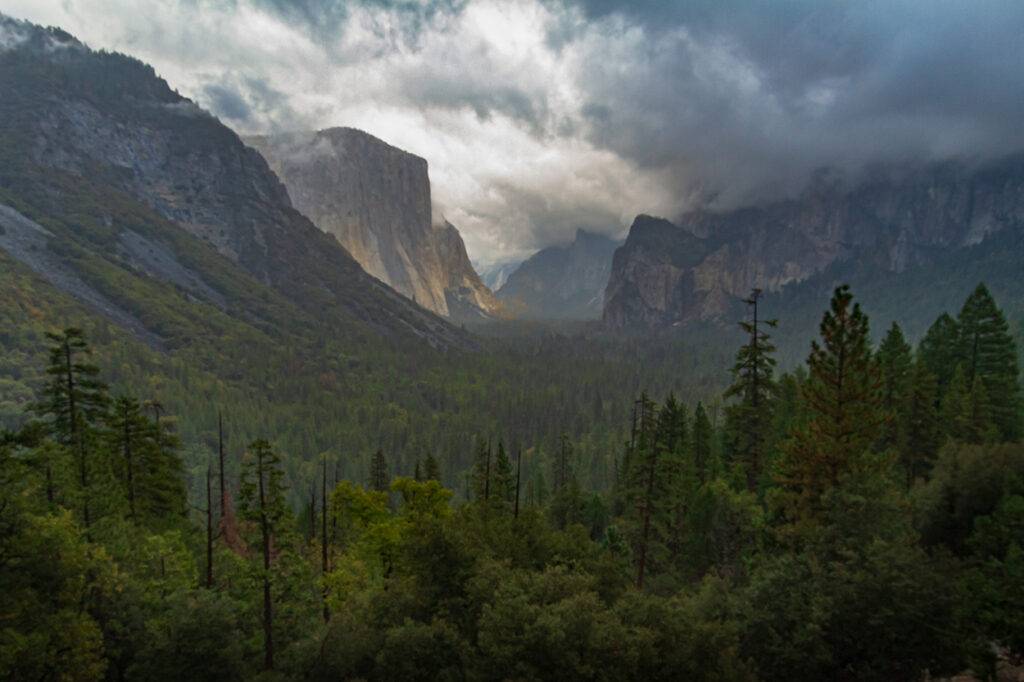Tunnel View, Yosemite National Park is a popular viewing and photography point overlooking Yosemite Valley. Certainly, I was lucky to capture a gathering storm in the photo below. From this viewpoint can be seen El Capitan on the left, and Cathedral Rocks on the right. In the distance, Half Dome is shrouded in clouds.
The indigenous people who originally lived in Yosemite Valley called it Ahwahnee, meaning “Gaping Mouth”, due to its appearance when seen from the valley floor. Ahwahneechees were people who lived in Ahwahnee.

YOSEMITE VALLEY (TUNNEL VIEW ABOVE) AND YOSEMITE INDIAN PETITION OF 1891
The Ahwahneechees (people of Ahwahnee) lived in Yosemite National Park for many millennia. That is, until the California Gold Rush. At that time conflicts arose between prospectors, new settlers (who arrived in tens of thousands to seek their fortunes), and the indigenous peoples. Consequently, the Governor of the newly formed State of California authorized the formation of the Mariposa Battalion. In 1851 these soldiers invaded Ahwahnee, eventually driving out the people from their homelands. Subsequently, the Ahwahneechees were taken into reservations. Afterward, members of the Battalion re-named Ahwahnee “Yosemite”.
At that time, the Chief of the Ahwahneechees was Tenaya. The Chief was born near Mono Lake to an Ahwahneechee father and Paiute mother. Ultimately, he proved to be their last Chief because he and his people were either killed or disbanded.
In 1891, a “Yosemite Indian Petition to the United States” was sent to the President and Congress.
The Yosemite Indian Petition opens:
“We, the undersigned chiefs and head men of the existing remnants of the tribes of the Yo-Semite, the Mono and the Piute Indians, who hold claims upon that gorge in the Sierra Nevada Mountains known as the Yosemite Valley, and the lands around and about it, by virtue of direct descent from the aforenamed tribes, who were inhabitants of that valley and said territory at the time when it was so unjustifiably conquered and taken from our fathers by the whites, do utter, petition and pray your Excellency and your honorable bodies in Congress assembled to hear, deliberate upon, and give us relief, for the following reasons to wit:”.
The opening part of their petition includes:
“1st. In all of the difficulties, disagreements, quarrels, and violences which sprang up between our fathers and the whites of their days, the first causes can invariably be traced to the overbearing tyranny and oppression of the white gold hunters, who had and who were continually usurping our territory. Those causes were briefly as follows: The white gold hunters brought among us drunkenness, lying, murder, forcible violation of our women, cheating, gambling, and wrongful appropriation of our lands for their own selfish uses.”…….
“We, as Indians and survivors of the aforenamed tribes, declare that we were unfairly and unjustly deprived of our possessions in land, made to labor in the interest of the whites for no recompense, subjected to continual brutality, wrong, and outrage at the hands of the whites, and were gradually driven from our homes into strange localities by their action”……
The action of the Mariposa Battalion towards our chief at that time, Tenaya, and his tribe was wantonly unjust and outrageous. Our only quarrel with the whites then was owing to our determination not to go upon a reservation being established on the Fresno, and give up to the whites this magnificent valley, which was to us reservation and all that we desired and that for a few paltry blankets, gewgaws and indifferent supplies of rations, that might be furnished us or not, at the discretion of any appointed Indian Agent
The Yosemite Indian Petition continues:
The Petition goes on to state their case and plea for recognition and indemnification.
Finally, it finishes with:
“Here we place our marks as opposite our names, the Chiefs and head men of the petitioning remnants of the former Yosemite tribes with our principal women and children”. These were “Yosemite Indians, Mono-Yosemites and Yosemite Indians, Women”.
It is believed that the author of the petition was the Yosemite artist, Charles Dormon Robinson. None of the petition signers was literate enough to be the author.
In short, the petition was unsuccessful, and no compensation was given.
Yosemite National Park Book – A Native American Fiction
The true and epic story of Chief Tenaya and the Ahwahneechees is re-told in the historical fiction Great Spirit of Yosemite: The Story of Chief Tenaya. This illustrated Yosemite book is a unique mix of actual historical events and imaginative storytelling. Moreover, it is the #1 book in Goodreads “Books to Read Before Visiting Yosemite“